Catholic Customs
 |
 |
 |
 |
 |
 |
 |
The Feast of St. Lucy Inspires
Charming Customs
The 13th of December is an important day for Catholics in Sweden and Italy. In these countries the Catholics have many beautiful customs centered around St. Lucy derived from the meaning of her name: "light."
How fitting it is since the winter solstice is fast approaching when days will soon be longer and brighter. This feast holds special honor in Swedish homes because of the severe winters when the darkness of the night consumes much of the day.
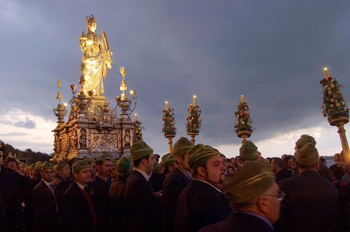 In Southern Italy, the people would honor St. Lucy with bonfires and torch-lit processions. In Naples, the people arise at dawn to light bonfires along the sea coast leading to the Shurch
Santa Lucia a Mare. The fishermen of Naples make sure to honor the Saint on her feast because of the assistance she gives them as they navigate the tempestuous seas during the dark days of winter.
In Southern Italy, the people would honor St. Lucy with bonfires and torch-lit processions. In Naples, the people arise at dawn to light bonfires along the sea coast leading to the Shurch
Santa Lucia a Mare. The fishermen of Naples make sure to honor the Saint on her feast because of the assistance she gives them as they navigate the tempestuous seas during the dark days of winter.
In Syracuse on the island of Sicily, the people have a grand torch-lit parade where they carry the statue of St. Lucy to the Basilica di Santa Lucia al Sepolcro, where the body of St. Lucy resides. The statue remains in the Basilica for seven days to be honored by the faithful; then another procession returns it to its resting place. These seven days are filled with fireworks, festivities and the eating of special foods.
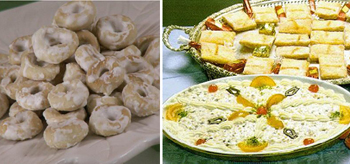 It is traditional in Italy to eat cuccia, a wheat porridge flavored with olive oil or honey in honor of the miracle that St. Lucy performed for the people of Syracuse, the area where St. Lucy lived. In 1646, there was an extreme famine led the people to have recourse to St. Lucy for help.
It is traditional in Italy to eat cuccia, a wheat porridge flavored with olive oil or honey in honor of the miracle that St. Lucy performed for the people of Syracuse, the area where St. Lucy lived. In 1646, there was an extreme famine led the people to have recourse to St. Lucy for help.
St. Lucy made haste to help them, answering their prayers by miraculously sending two ships laden with grain. The people were so overjoyed that they boiled the wheat whole to make porridge rather than grind the miraculous wheat into flour.
Many Sicilians abstain from bread and pasta on this day and throughout the octave to honor the Saint and the miraculous wheat she provided.
In Northern Italy, the people have different customs reflecting the favors that St. Lucy has shown to them. In the 14th century, many of the children of the city of Verona were afflicted with an eye disease that was spreading rapidly. They turned to St. Lucy, a patroness of people with eye afflictions because of her sufferings when her eyes were gouged out during her martyrdom.
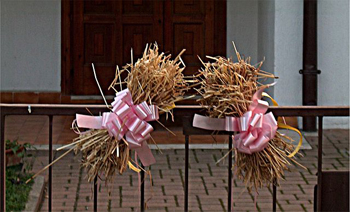 The parents of the afflicted children walked barefoot to the shrine of St. Lucy to beg for her intercession. To encourage the children to join in that cold and arduous walk, the parents promised them that St. Lucy would bring them treats for honoring her. The prayers of the people of Verona proved to be effectual, as all of the children were soon healed of the disease and grateful to the marvelous Saint.
The parents of the afflicted children walked barefoot to the shrine of St. Lucy to beg for her intercession. To encourage the children to join in that cold and arduous walk, the parents promised them that St. Lucy would bring them treats for honoring her. The prayers of the people of Verona proved to be effectual, as all of the children were soon healed of the disease and grateful to the marvelous Saint.
To honor this favor, Italians from Veneto and Lombardy have their children write letters to St. Lucy on the eve of her feast (December 12). On that special night, the children know, St. Lucy travels in a gift-laden carriage pulled by a donkey and accompanied by an assistant called Castaldo. She is often depicted on her journey wearing una corona di candele – a crown of candles – to illuminate her dark route.
Milk or coffee are set out for St. Lucy, hay for her donkey, and wine and biscuits for Castaldo, her escort who accompanies her to bring good children their gifts. The children are warned to close their eyes tight on December 12 when they go to bed lest St. Lucy throw ashes in their eyes for their over anxious curiosity. Children who obey these rules arise from their beds to find toys and sweets in place of the food they left out for St. Lucy.
A popular treat of the day is gli occhi di Santa Lucia, Saint Lucy's Eyes, which are the traditional small Tarallini made in the Saint's honor.
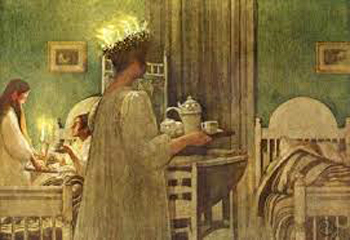 The traditions in Sweden are inspired by another miraculous event of St. Lucy. There was a famine in the southwest of Sweden causing real desolation. On December 13, The people looked out at Lake Vannern and saw a magnificently lighted ship approaching the shore. When the ship came close to the shore, the people saw a beautiful woman in a white gown with a circle of light around her head carrying a basket of bread. Soon afterwards, the famine ceased. The people attributed this assistance to St. Lucy about whom they had learned from the Catholic missionaries.
The traditions in Sweden are inspired by another miraculous event of St. Lucy. There was a famine in the southwest of Sweden causing real desolation. On December 13, The people looked out at Lake Vannern and saw a magnificently lighted ship approaching the shore. When the ship came close to the shore, the people saw a beautiful woman in a white gown with a circle of light around her head carrying a basket of bread. Soon afterwards, the famine ceased. The people attributed this assistance to St. Lucy about whom they had learned from the Catholic missionaries.
The Swedes have a very special way to honor St. Lucy for her miraculous intervention on this day.
In Sweden, the eldest daughter of every family plays a prominent role. On the eve of December 13th, she bakes special ginger cookies and buns called lussekatter. Early in the morning before dawn, she dresses in a white gown with a red sash (symbolizing the blood St. Lucy spilt in her martyrdom) and a wreath crown made of the branches of a Lingonberry tree to symbolize new life. On that crown she wears on her head are seven lighted candles.
She goes from room to room bringing coffee, cookies, buns, and
glögg (a spiced mulled wine) to all the family members, escorted by her younger sisters and brothers. The younger girls (tärnor) wear white gowns with tinsel in their hair and the boys dress as star boys (Stjärngossar) in pointed white caps, white robes and sticks decorated with stars.
A procession of all of the Lucias follows, the group going to each house in the neighborhood or area singing the traditional St. Lucy songs and carrying burning candles.
These processions of St. Lucy are not only reserved for families. Many hotels, schools and hospitals also choose girls to dress as St. Lucy to deliver treats and sing carols and hymns to the residents there.
This custom has a counterpart in Italy, where each year a girl from Sweden is elected to be the Lucia for the procession in Syracuse on December 20th when the statue is ceremoniously returned to its original Cathedral.
These beautiful customs from two different countries show how the liturgical customs used to inspire whole communities in the past to make a feast day marvelous to give greater glory to God and a special saint.
Many of these customs could be restored in families and communities in a solemn and marvelous manner that lifts all the minds to Heaven where the Saint of Light sings in the glorious Choir of Virgins. It is a way to invite Heaven to work miracles again for the faithful through the intercession of the members of the Church Triumphant, the Saints.
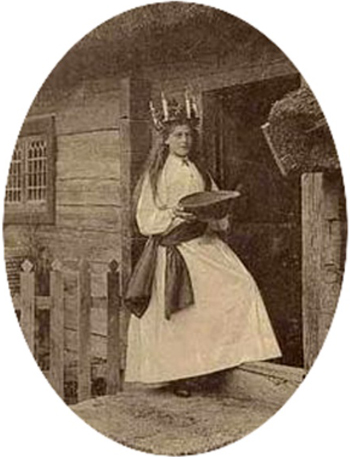
How fitting it is since the winter solstice is fast approaching when days will soon be longer and brighter. This feast holds special honor in Swedish homes because of the severe winters when the darkness of the night consumes much of the day.

The torch lit procession in Syracuse to honor St. Lucy
In Syracuse on the island of Sicily, the people have a grand torch-lit parade where they carry the statue of St. Lucy to the Basilica di Santa Lucia al Sepolcro, where the body of St. Lucy resides. The statue remains in the Basilica for seven days to be honored by the faithful; then another procession returns it to its resting place. These seven days are filled with fireworks, festivities and the eating of special foods.

St. Lucy's Eyes and the wheat porridge cuccia are traditional St. Lucy day foods
St. Lucy made haste to help them, answering their prayers by miraculously sending two ships laden with grain. The people were so overjoyed that they boiled the wheat whole to make porridge rather than grind the miraculous wheat into flour.
Many Sicilians abstain from bread and pasta on this day and throughout the octave to honor the Saint and the miraculous wheat she provided.
In Northern Italy, the people have different customs reflecting the favors that St. Lucy has shown to them. In the 14th century, many of the children of the city of Verona were afflicted with an eye disease that was spreading rapidly. They turned to St. Lucy, a patroness of people with eye afflictions because of her sufferings when her eyes were gouged out during her martyrdom.

The traditional hay left outdoors for St. Lucy's donkey
To honor this favor, Italians from Veneto and Lombardy have their children write letters to St. Lucy on the eve of her feast (December 12). On that special night, the children know, St. Lucy travels in a gift-laden carriage pulled by a donkey and accompanied by an assistant called Castaldo. She is often depicted on her journey wearing una corona di candele – a crown of candles – to illuminate her dark route.
Milk or coffee are set out for St. Lucy, hay for her donkey, and wine and biscuits for Castaldo, her escort who accompanies her to bring good children their gifts. The children are warned to close their eyes tight on December 12 when they go to bed lest St. Lucy throw ashes in their eyes for their over anxious curiosity. Children who obey these rules arise from their beds to find toys and sweets in place of the food they left out for St. Lucy.
A popular treat of the day is gli occhi di Santa Lucia, Saint Lucy's Eyes, which are the traditional small Tarallini made in the Saint's honor.

The eldest daughter in her candle crown serves breakfast to her parents & adults of the household
The Swedes have a very special way to honor St. Lucy for her miraculous intervention on this day.
In Sweden, the eldest daughter of every family plays a prominent role. On the eve of December 13th, she bakes special ginger cookies and buns called lussekatter. Early in the morning before dawn, she dresses in a white gown with a red sash (symbolizing the blood St. Lucy spilt in her martyrdom) and a wreath crown made of the branches of a Lingonberry tree to symbolize new life. On that crown she wears on her head are seven lighted candles.
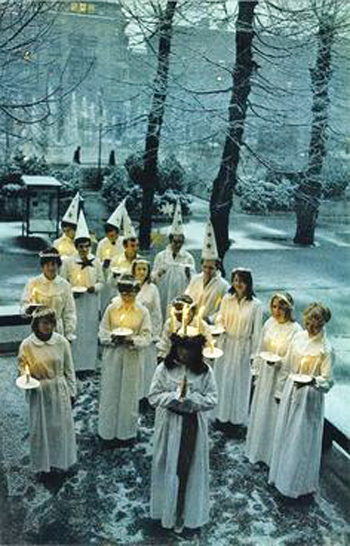
The Lucias process ceremoniously
with the star boys in white hats
A procession of all of the Lucias follows, the group going to each house in the neighborhood or area singing the traditional St. Lucy songs and carrying burning candles.
These processions of St. Lucy are not only reserved for families. Many hotels, schools and hospitals also choose girls to dress as St. Lucy to deliver treats and sing carols and hymns to the residents there.
This custom has a counterpart in Italy, where each year a girl from Sweden is elected to be the Lucia for the procession in Syracuse on December 20th when the statue is ceremoniously returned to its original Cathedral.
These beautiful customs from two different countries show how the liturgical customs used to inspire whole communities in the past to make a feast day marvelous to give greater glory to God and a special saint.
Many of these customs could be restored in families and communities in a solemn and marvelous manner that lifts all the minds to Heaven where the Saint of Light sings in the glorious Choir of Virgins. It is a way to invite Heaven to work miracles again for the faithful through the intercession of the members of the Church Triumphant, the Saints.


Posted December 11, 2019
______________________
______________________
 |
 |
 |
 |
 |
 |


